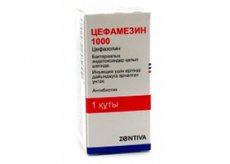Medical expert of the article
New publications
Preparations
Cefamezin
Last reviewed: 23.04.2024

All iLive content is medically reviewed or fact checked to ensure as much factual accuracy as possible.
We have strict sourcing guidelines and only link to reputable media sites, academic research institutions and, whenever possible, medically peer reviewed studies. Note that the numbers in parentheses ([1], [2], etc.) are clickable links to these studies.
If you feel that any of our content is inaccurate, out-of-date, or otherwise questionable, please select it and press Ctrl + Enter.

Cefamezin is an antibiotic from the group of cephalosporins (1st generation). It has a wide range of medicinal activity and bactericidal properties.
 [1]
[1]
Indications of the cefamezin
It is used to eliminate pathologies of infectious and inflammatory origin, provoked by the activity of microbes sensitive to cefazolin:
- diseases affecting the lower and upper region of the respiratory system;
- pathology within the GVP and urinary system, and also in the area of soft tissues, joints with bones, organs within the small pelvis, and also on the skin;
- sepsis with endocarditis, mastitis with osteomyelitis, and in addition, otitis media and peritonitis;
- infections that occur after burns, surgical procedures and wounds;
- gonorrhea or syphilis.
Pharmacodynamics
The drug is active relatively:
- Gram-positive microbes: staphylococci (strains that produce and do not produce penicillinase), streptococci (here also included pneumococci), diphtheria corynebacterium and anthrax bacilli;
- Gram-negative microbes: gonococcus, meningococcus, salmonella, shigella, klebsiella and E. Coli.
In addition, it affects Leptospira spp, as well as Spirochaetoceae.
Has no effect on the activity of Pseudomonas aeruginosa, anaerobes, indole-positive strains of proteas, and also Mycobacterium tuberculosis.
Pharmacokinetics
After intravenous injection, stable plasma LA values are observed after 3 hours. The active element quickly passes through the placenta, synovia and histohematological barriers. A small part of the substance is excreted with the mother's milk. The level of the drug inside the bone tissue is similar to its plasma parameters.
Excretion of the unmodified element mainly occurs by filtering the glomeruli. With intramuscular injection, 0.5 g of excretion of 56-89% of LS occurs within 6 hours, and 80-100% in 24 hours. The peak values of the drug in the urine are 1 + g / l, and with intramuscular injection of the 1st g solution the maximum urinary index is 4 g / l.
Dosing and administration
The dosage regimen is determined separately for each person. This takes into account the severity of the disease, the location of the infection process, as well as the sensitivity of the pathogen.
The medication is administered intramuscularly or intravenously (by jet or drop method). For a day, on average, adults need a portion of 1 g, with a frequency of 2-4 times / day.
To prevent infection after surgical intervention, it is necessary to administer drugs in a dose of 1 g for half an hour before the operation, then another 0.5-1 g already during the procedure, and then another 0.5-1 g for the next day after the operation (at intervals of 6-8 hours).
For the day, no more than 6 g of the drug can be administered.
Children need to administer 20-40 mg / kg of substance per day. If a severe degree of infection is observed, it is possible to increase the dose to 100 mg / kg / day. The duration of therapy is 7-10 days.
 [22]
[22]
Use of the cefamezin during pregnancy
The use of Cefamezin in a nursing or pregnant woman is allowed only in situations where a possible benefit for it will be more likely than the occurrence of complications in the fetus or baby.
Contraindications
The main contraindications: infants up to 1 month, as well as the presence of hypersensitivity to cephalosporins.
Caution is required when using in people with kidney problems.

Side effects of the cefamezin
The use of drugs sometimes causes the development of the following side effects:
- lesions affecting digestive activity: vomiting, nausea, or diarrhea may occur. Occasionally there is a transient increase in the activity of liver transaminases;
- manifestations of allergies: itching, hives, fever or eosinophilia may develop. Single noted arthralgia, angioedema or anaphylaxis;
- signs caused by chemotherapeutic effects: development of colitis pseudomembranous nature, as well as candidiasis;
- violations of the hemopoietic function: occasionally there is curable leukopenia, and in addition thrombocytopenia or neutropenia;
- disorders of urinary function: occasionally develops functional renal impairment;
- local symptoms: pain may occur on the site of the injection.
Overdose
When parenteral injection in a large dosage may cause headaches, paresthesias and dizziness. In the case of drug intoxication or during its cumulation in a person with kidney failure in a chronic stage, neurotoxic symptoms may develop. In such situations, there is increased convulsive alertness, vomiting, generalized clonicotonic cramps, and tachycardia.
When the victim has toxic symptoms, and in addition, with overdose of the drug, accelerate its excretion from the body can be through the procedure of hemodialysis. But peritoneal dialysis will be ineffective.
Interactions with other drugs
Combination of the drug with loop diuretics causes blockade of the tubular secretion of cefazolin (therefore this combination is not recommended for use).
The active element of Cefamesin can lead to the development of disulfiram-like action in case of combination with ethyl alcohol.
Probenecid interferes with the excretion of cefazolin.
Attention!
To simplify the perception of information, this instruction for use of the drug "Cefamezin" translated and presented in a special form on the basis of the official instructions for medical use of the drug. Before use read the annotation that came directly to medicines.
Description provided for informational purposes and is not a guide to self-healing. The need for this drug, the purpose of the treatment regimen, methods and dose of the drug is determined solely by the attending physician. Self-medication is dangerous for your health.

